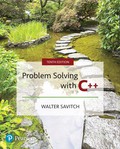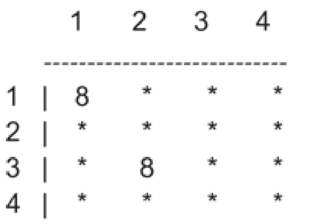
A common memory matching game played by young children is to start with a deck of cards that contains identical pairs. For example, given six cards in the deck, two might be labeled “1,” two might be labeled “2,” and two might be labeled “3.” The cards are shuffled and placed face down on the table. The player then selects two cards that are face down, turns them face up, and if they match they are left face up. If the two cards do not match, they are returned to their original position face down. The game continues in this fashion until all cards are face up. Write a program that plays the memory matching game. Use 16 cards that are laid out in a 4 × 4 square and are labeled with pairs of numbers from 1 to 8. Your program should allow the player to specify the cards that she would like to select through a coordinate system. For example, suppose the cards are in the following layout:

All of the cards are face down except for the pair 8, which has been located at coordinates (1, 1) and (2, 3). To hide the cards that have been temporarily placed face up, output a large number of newlines to force the old board off the screen.
(Hint: Use a two-dimensional array for the arrangement of cards and another two-dimensional array that indicates if a card is face up or face down. Write a function that “shuffles” the cards in the array by repeatedly selecting two cards at random and swapping them. Random number generation is described in Chapter 4.)
Want to see the full answer?
Check out a sample textbook solution
Chapter 7 Solutions
Problem Solving with C++ (10th Edition)
Additional Engineering Textbook Solutions
Mechanics of Materials (10th Edition)
Web Development and Design Foundations with HTML5 (8th Edition)
Starting Out with Java: From Control Structures through Objects (7th Edition) (What's New in Computer Science)
Management Information Systems: Managing The Digital Firm (16th Edition)
SURVEY OF OPERATING SYSTEMS
Starting Out with C++ from Control Structures to Objects (9th Edition)
- Dijkstra's Algorithm (part 1). Consider the network shown below, and Dijkstra’s link-state algorithm. Here, we are interested in computing the least cost path from node E (note: the start node here is E) to all other nodes using Dijkstra's algorithm. Using the algorithm statement used in the textbook and its visual representation, complete the "Step 0" row in the table below showing the link state algorithm’s execution by matching the table entries (i), (ii), (iii), and (iv) with their values. Write down your final [correct] answer, as you‘ll need it for the next question.arrow_forward4. |z + 5 - 5i| = 7arrow_forward14. dz, C: |z❘ C: |z❘ = 0.6 ze² - 2iz Harrow_forward
 C++ for Engineers and ScientistsComputer ScienceISBN:9781133187844Author:Bronson, Gary J.Publisher:Course Technology Ptr
C++ for Engineers and ScientistsComputer ScienceISBN:9781133187844Author:Bronson, Gary J.Publisher:Course Technology Ptr EBK JAVA PROGRAMMINGComputer ScienceISBN:9781337671385Author:FARRELLPublisher:CENGAGE LEARNING - CONSIGNMENT
EBK JAVA PROGRAMMINGComputer ScienceISBN:9781337671385Author:FARRELLPublisher:CENGAGE LEARNING - CONSIGNMENT C++ Programming: From Problem Analysis to Program...Computer ScienceISBN:9781337102087Author:D. S. MalikPublisher:Cengage Learning
C++ Programming: From Problem Analysis to Program...Computer ScienceISBN:9781337102087Author:D. S. MalikPublisher:Cengage Learning Microsoft Visual C#Computer ScienceISBN:9781337102100Author:Joyce, Farrell.Publisher:Cengage Learning,Programming Logic & Design ComprehensiveComputer ScienceISBN:9781337669405Author:FARRELLPublisher:Cengage
Microsoft Visual C#Computer ScienceISBN:9781337102100Author:Joyce, Farrell.Publisher:Cengage Learning,Programming Logic & Design ComprehensiveComputer ScienceISBN:9781337669405Author:FARRELLPublisher:Cengage EBK JAVA PROGRAMMINGComputer ScienceISBN:9781305480537Author:FARRELLPublisher:CENGAGE LEARNING - CONSIGNMENT
EBK JAVA PROGRAMMINGComputer ScienceISBN:9781305480537Author:FARRELLPublisher:CENGAGE LEARNING - CONSIGNMENT





